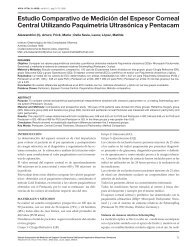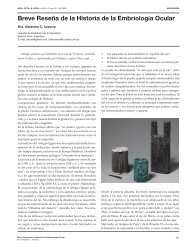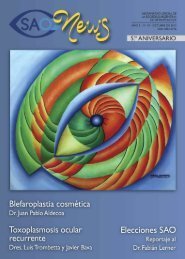Volumen 79 Número 1 - Sociedad Argentina de Oftalmología
Volumen 79 Número 1 - Sociedad Argentina de Oftalmología
Volumen 79 Número 1 - Sociedad Argentina de Oftalmología
You also want an ePaper? Increase the reach of your titles
YUMPU automatically turns print PDFs into web optimized ePapers that Google loves.
have any financial interest in a company related<br />
to the product or that of competitors; whether<br />
they are employees or consultants of said<br />
company or have been in the past three years,<br />
or of a competitor company. Similarly, they must<br />
mention any financial aid received from any<br />
company involved in the research, providing<br />
<strong>de</strong>tails thereof<br />
If none of the above fits the<br />
circumstances, the authors must state that they<br />
do not have any commercial interest and have<br />
not received financial support.<br />
The final phrase shall be: «The<br />
author/s certify that this article has not<br />
been published or is being consi<strong>de</strong>red for<br />
publication in another journal. In addition,<br />
they transfer the property rights (Copyright)<br />
to the <strong>Sociedad</strong> Española <strong>de</strong> <strong>Oftalmología</strong>»¸<br />
followed by the signature of all authors in the<br />
or<strong>de</strong>r of appearance in the publication.<br />
o Abstract and key words<br />
The abstract must appear first in<br />
English and then in Spanish, both versions<br />
having the same content. The abstract must<br />
not exceed 250 words and it must present the<br />
purpose of the research or study (Objective);<br />
the basic procedures (selection of individuals<br />
or animals for experimentation, observation<br />
and analysis methods) (Methods); the main<br />
findings (providing specific data and statistical<br />
significance if possible) (Results), and the main<br />
conclusions (Conclusions). Also, the Abstract<br />
must emphasise the novel and most relevant<br />
features of the study or the observations.<br />
«It must be taken into account that the<br />
Abstracts must be intelligible and consistent with<br />
the article they head, i.e., must inclu<strong>de</strong> the basic<br />
information of the article in the same style, as<br />
concise as possible, respecting at the same time<br />
the content of the text and refraining from quoting<br />
secondary information or including information<br />
which is not referred to in the document.»<br />
After the Abstract, 8 key words or short<br />
phrases must be inclu<strong>de</strong>d and i<strong>de</strong>ntified as such,<br />
which must likewise be in English and Spanish. It<br />
is very important to take into account that terms<br />
from the «Medical Subject Headings» of In<strong>de</strong>x<br />
Medicus should be used. If the appropriate terms<br />
Archivos <strong>de</strong> <strong>Oftalmología</strong> 2008; <strong>79</strong><br />
are not yet in said MeSH due to being of recent<br />
introduction, current terms can be used. The use of<br />
words recognised in a controlled and specialised<br />
vocabulary such as MeSH makes it much easier to<br />
access published articles from the Bibliographic<br />
Databases. To facilitate the use of MeSH terms,<br />
Archivos has set up a link in its website, http://<br />
www.nlm.nih.gov/mesh/meshhome.html<br />
o Text<br />
Length as indicated above. Any<br />
quotes or contributions by other authors must<br />
be specified by an Arabic number in brackets,<br />
supported by the corresponding bibliographical<br />
reference. If the same literature is repeated in<br />
successive quotes, the number of the first shall<br />
be used.<br />
The text will comprise the following sections:<br />
· Introduction<br />
· Subject, material and method<br />
· Results<br />
· Discussion<br />
· Acknowledgements<br />
· Introduction<br />
It should be brief, concise and directly<br />
related to the work, omitting extensive reviews<br />
of literature and quotes, clearly setting the<br />
objective and hypotheses of the work.<br />
· Subject, material and method<br />
Specify the patients, animals or<br />
vegetables on which the work was carried out. For<br />
presentations involving human beings, indicate<br />
if the procedures complied with the ethical rules<br />
of the committee in charge of experiments with<br />
humans (institutional or regional) or with the<br />
197 Helsinki Declaration (revised version 1983).<br />
Names of patients, initials or hospital numbers<br />
must be omitted, particularly in illustrations.<br />
Mention must be ma<strong>de</strong> of the material,<br />
specifying brand and mo<strong>de</strong>l, when this can have<br />
an influence on the results. Briefly <strong>de</strong>scribe the<br />
research procedure, <strong>de</strong>tailing only the inhouse<br />
or unusual methods, mentioning methods of<br />
others by reference only.<br />
Statistics: Describe the statistical<br />
methods in sufficient <strong>de</strong>tail to allow a<br />
wellinformed rea<strong>de</strong>r, with access to the original<br />
data, to verify the results. The findings should<br />
[ 73 ]






